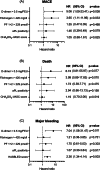D-dimer and fibrinogen indicate ischemic risk in patients with atrial fibrillation after percutaneous coronary intervention
- PMID: 38773510
- PMCID: PMC11107060
- DOI: 10.1186/s12959-024-00610-x
D-dimer and fibrinogen indicate ischemic risk in patients with atrial fibrillation after percutaneous coronary intervention
Abstract
Background: This study aimed to evaluate the association of antiphospholipid antibodies (aPL) and conventional markers of coagulation with ischemic and bleeding risk in patients with atrial fibrillation (AF) undergoing percutaneous coronary intervention (PCI).
Methods: In this prospective two-center observational cohort study, patients with AF and an indication for oral anticoagulation (OAC) were enrolled after PCI. Blood was drawn on day 1-3 after PCI. Dilute Russell's viper venom time was used to determine lupus anticoagulant (LA) in OAC-free plasma. Anti-cardiolipin (aCL) IgG, IgM, and anti-β2-Glycoprotein 1 (aβ2GP1) IgG were analyzed by enzyme-linked immunosorbent assay (ELISA). Fibrinogen (FIB), d-dimer, and prothrombin fragment 1 and 2 (PF 1 + 2) were measured in citrated plasma. The primary ischemic outcome was time to major adverse cardiovascular events (MACE; death, myocardial infarction, or stroke) assessed at 6 months. Bleeding was defined according to International Society on Thrombosis and Haemostasis.
Results: 158 patients were enrolled between May 2020 and May 2021 on day 1-3 after PCI. The median age was 78 years (interquartile range [IQR] 72-82), 111 (70%) were male, and 39 (25%) presented with acute coronary syndrome. D-dimer was elevated in 74 (47%) patients, FIB was increased in 40 (25%) and PF1 + 2 in 68 (43%) patients. 32 (20%) patients had ≥ 1 antiphospholipid antibody elevated (aPL; LA: 19 [12%], aCL: 14 [9%], aβ2GP1: 2 [1%]). The presence of aPL was neither significantly associated with MACE (HR 1.46, 95% CI [0.39-5.49], p = 0.579), nor bleeding (HR 1.07 [0.30-3.84], p = 0.917). Elevated d-dimer was significantly associated with higher risk for MACE (HR 5.06 [1.09-23.41], p = 0.038) and major bleeding (HR 7.04 [1.58-31.47], p = 0.011). Elevated D-dimer increased the predictive capacity of HAS-BLED for major bleedings (HAS-BLED: AUC 0.71 [0.60-0.83] vs. HAS-BLED + d-dimer: AUC 0.79 [0.70-0.88]; p = 0.025). Increased levels of FIB were associated with higher risk for MACE (HR 3.65 [1.11-11.96], p = 0.033).
Conclusion: Biomarkers of coagulation might be suitable to assess ischemic and bleeding risk in patients with AF following PCI.
Keywords: Antiphospholipid antibodies; Atrial fibrillation; Coagulation markers; Fibrinogen; Percutaneous coronary intervention; Prothrombin fragments 1 and 2; d-dimer.
© 2024. The Author(s).
Conflict of interest statement
CBO received research support from Deutsche Forschungsgemeinschaft, Deutsche Herzstiftung, University of Freiburg, Else Kröner-Fresenius Stiftung, and Haemonetics; Honoraria: Bayer Vital GmbH, BMS, Böhringer Ingelheim, Daiichi Sankyo, Ferrer, Idorsia, and Janssen. DT received research funding from the German Cardiac Foundation and speakers fee and honoraria for advisory board activity from AstraZeneca, ATRIVA Therapeutics, Bayer, Daiichi Sankyo, DP-Medsystems, Ferrer and Novartis.
Figures


References
-
- Hindricks G, Potpara T, Dagres N, Arbelo E, Bax JJ, Blomström-Lundqvist C. 2020 ESC guidelines for the diagnosis and management of atrial fibrillation developed in collaboration with the European Association of Cardio-Thoracic Surgery (EACTS)the Task Force for the diagnosis and management of atrial fibrillation of the European Society of Cardiology (ESC) developed with the special contribution of the European Heart Rhythm Association (EHRA) of the ESC. Eur Heart J. - PubMed
-
- Coppens M, Eikelboom JW, Hart RG, Yusuf S, Lip GYH, Dorian P. u. a. The CHA2DS2-VASc score identifies those patients with atrial fibrillation and a CHADS2 score of 1 who are unlikely to benefit from oral anticoagulant therapy. Eur Heart J 14 Januar. 2013;34(3):170–6. doi: 10.1093/eurheartj/ehs314. - DOI - PubMed
LinkOut - more resources
Full Text Sources
Miscellaneous

